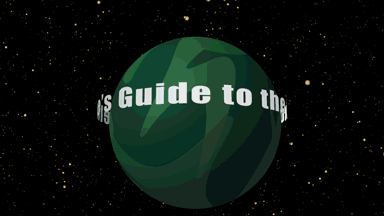Scienceline’s Guide to the Exoplanets: The Roundabout
Proxima Centauri b: A landmark in the next celestial village over
Rahul Rao • June 15, 2020

Your favorite planets, and you didn't even know they existed. [Credit: Curtis Segarra | CC BY-NC-ND 2.0]
Your favorite planets, and you didn't even know they existed. [Credit: Curtis Segarra | CC BY-NC-ND 2.0]
The Roundabout
Proxima Centauri b
Discovered by: Guillem Anglada‐Escudé, et al
Discovered: 2016
Distance from Earth: ~4.24 light-years
Size: ~1.3 Earth radii
Mass: ~1.6 Earth masses
Surface climate: Unknown
Habitability for humans: Do you like stellar wind?
This week, we’re talking about a planet that by all rights should be utterly random and insignificant. It’s a (probably) rocky planet very slightly bigger than the Earth — not very big — orbiting very close to an entirely ordinary red dwarf that’s only the third-largest and third most luminous star in its star system.
That entirely ordinary red dwarf just happens to be Proxima Centauri, the nearest star to the Sun. That makes Proxima Centauri b, the first exoplanet discovered around that red dwarf, the closest known exoplanet to Earth.
Proxima Centauri is the third star in the Alpha Centauri system, about four light-years from the Earth. It wasn’t the first time scientists had tried to look for exoplanets in the system: in 2012, astronomers had announced the discovery of Alpha Centauri Bb, orbiting the second star in the system. That announcement attracted skepticism from the start, and was disproven in 2015.
But in 2016, other astronomers with the European Southern Observatory announced something more exciting — and something, more likely than not, far more real.
Proxima Centauri b is quite Earthlike in size. Furthermore, Proxima Centauri b is actually within the habitable zone of its star. It’s entirely possible that liquid water might exist on its surface.
Before you get too excited about building generation ships and hurriedly seeding this planet with human habitats, it’s not certain whether the planet is even habitable for humans. One of the largest problems is stellar wind: the planet is bombarded with 2000 times the amount of ionizing high-energy electrons and protons than the Earth. That much would be enough to strip away any atmosphere on the planet.
Then again, it’s almost as if Proxima Centauri b’s habitability doesn’t really matter. Proxima Centauri b’s relatively close distance to Earth, for an exoplanet, makes it an exciting goal for people planning (or dreaming) of interstellar spaceflight. One startup wants to use lasers to push an insect-sized probe to visit the planet. And a NASA/JPL group has begun conceptual studies for another probe there…for 2069.
That date makes the effort almost laughable — imagine if SpaceX’s recent launch had been planned all the time as Apollo 11 touched down on the Moon in 1969. But Proxima Centauri b’s discovery means that, for the first time in history, there is something very tangible in the nearest star system for humans to reach.